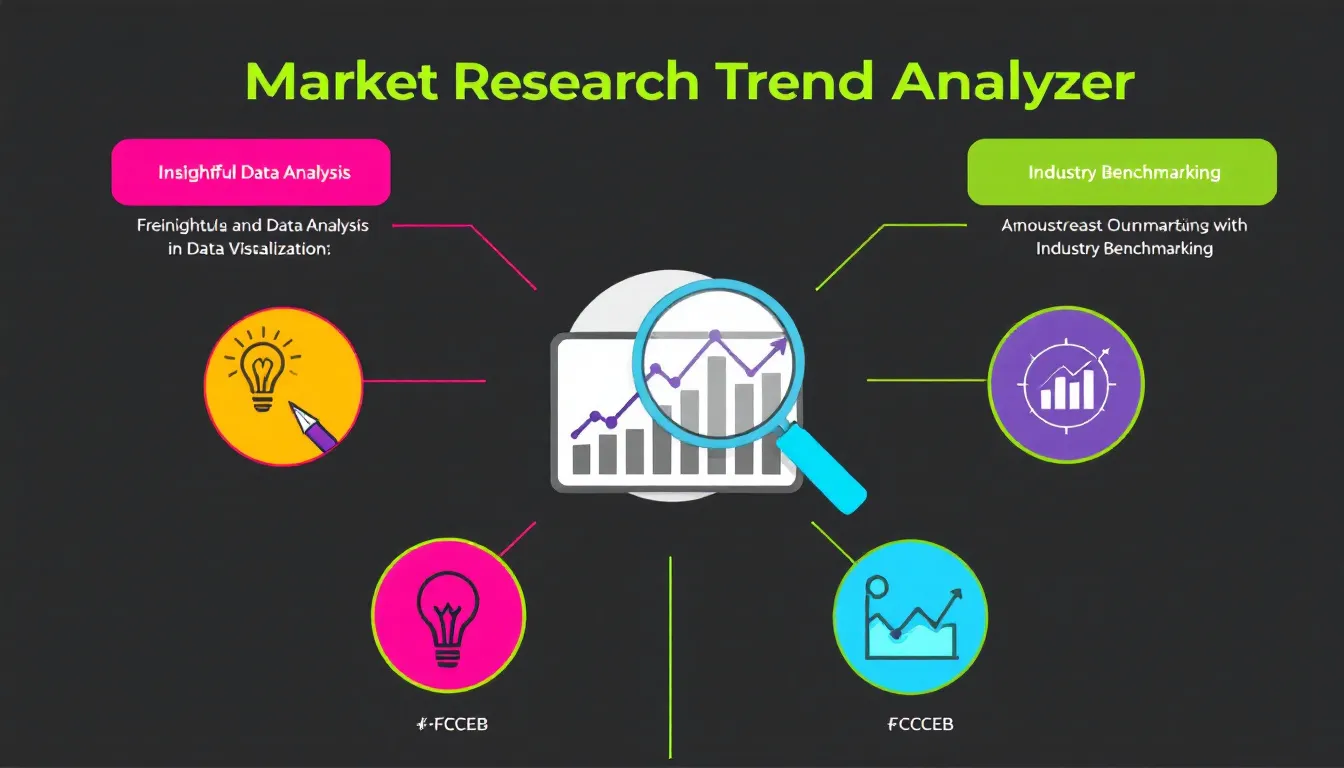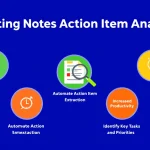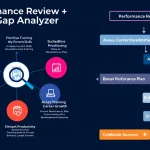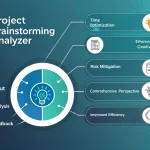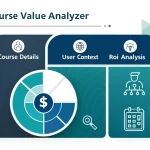Is this tool helpful?
How to Use the Market Research Trend Analysis Tool Effectively
Our Market Research Trend Analysis Tool is designed to provide you with comprehensive insights into the latest trends in your chosen industry. Here’s a step-by-step guide on how to use this tool effectively:
- Enter the Industry: In the input field labeled “The specific industry for which the market research and trend analysis should be conducted,” type in the name of the industry you want to analyze. Be as specific as possible to get the most relevant results. For example, you could enter “Artificial Intelligence in Healthcare” or “Sustainable Fashion.”
- Submit the Form: Once you’ve entered the industry, click the “Generate Market Research Summary” button. The tool will then process your request and generate a detailed market research summary.
- Review the Results: The generated summary will appear in the “Market Research Summary” section below the form. Take your time to read through the comprehensive analysis of current trends, their impact on the industry, and potential future implications.
- Copy the Results: If you want to save or share the generated summary, simply click the “Copy to Clipboard” button. This will allow you to paste the entire summary into a document or email for future reference.
To illustrate, let’s consider two sample inputs:
- Sample Input 1: “Electric Vehicle Manufacturing”
- Sample Input 2: “Plant-based Protein Food Industry”
By entering these specific industries, you’ll receive tailored market research summaries that focus on the unique trends, challenges, and opportunities within each sector.
Understanding the Market Research Trend Analysis Tool
In today’s rapidly evolving business landscape, staying ahead of industry trends is crucial for making informed decisions and maintaining a competitive edge. Our Market Research Trend Analysis Tool is a powerful resource designed to provide decision-makers, entrepreneurs, and industry professionals with up-to-date, comprehensive insights into the latest trends shaping their specific industry.
Definition and Purpose
This tool is an advanced, AI-powered market research assistant that specializes in identifying, analyzing, and summarizing current and emerging trends within any given industry. Its primary purpose is to consolidate vast amounts of market data and expert opinions into a concise, actionable summary that highlights key trends, their impact on the industry, and potential future developments.
Benefits of Using the Tool
Utilizing our Market Research Trend Analysis Tool offers numerous advantages:
- Time-Saving: Instead of spending hours or days scouring various sources for industry insights, you can obtain a comprehensive summary in minutes.
- Up-to-Date Information: The tool accesses the latest data and reports, ensuring that the trends identified are current and relevant.
- Customized Insights: By focusing on your specific industry, the tool provides tailored information that’s directly applicable to your business or area of interest.
- Strategic Decision-Making: The insights gained can inform strategic planning, product development, and investment decisions.
- Competitive Advantage: Staying ahead of trends allows you to anticipate market changes and adapt more quickly than competitors.
- Comprehensive Analysis: The tool not only identifies trends but also analyzes their impact and potential future implications, providing a holistic view of the industry landscape.
Benefits of Using the Market Research Trend Analysis Tool
1. Enhanced Strategic Planning
One of the primary benefits of using our Market Research Trend Analysis Tool is its ability to enhance your strategic planning process. By providing insights into current and emerging trends, the tool enables you to:
- Align your business strategies with market directions
- Identify potential opportunities for growth and innovation
- Anticipate and prepare for industry challenges
- Make data-driven decisions with greater confidence
2. Improved Resource Allocation
Understanding industry trends allows for more efficient allocation of resources:
- Focus investments on areas with the highest growth potential
- Redirect resources from declining sectors to emerging opportunities
- Optimize R&D efforts by aligning them with market demands
- Streamline operations based on industry best practices and emerging technologies
3. Risk Mitigation
The tool helps in identifying potential risks and challenges in your industry:
- Recognize early warning signs of market shifts
- Prepare contingency plans for potential disruptions
- Adapt your business model to changing consumer preferences
- Stay compliant with evolving industry regulations and standards
4. Competitive Intelligence
Gain a competitive edge by staying informed about industry-wide developments:
- Benchmark your strategies against industry trends
- Identify gaps in the market that your business can fill
- Anticipate competitors’ moves based on industry patterns
- Differentiate your offerings in a crowded marketplace
5. Innovation Catalyst
The insights provided by the tool can spark innovation within your organization:
- Identify emerging technologies that could revolutionize your industry
- Discover new product or service opportunities
- Adapt successful strategies from related industries
- Foster a culture of innovation by keeping teams informed about industry advancements
6. Investor Relations and Funding
For businesses seeking investment or funding, the tool provides valuable information:
- Support pitch decks with data-driven industry insights
- Demonstrate market potential to investors
- Justify business plans with trend-based projections
- Align your vision with industry growth trajectories
7. Customer-Centric Approach
Understanding industry trends often translates to better understanding customer needs:
- Align product development with evolving customer preferences
- Anticipate shifts in consumer behavior
- Improve customer experience based on industry best practices
- Develop marketing strategies that resonate with current market sentiments
Addressing User Needs and Solving Specific Problems
Our Market Research Trend Analysis Tool is designed to address a variety of user needs and solve specific problems faced by businesses and professionals across industries. Let’s explore how this tool can be applied to real-world scenarios:
1. Identifying Market Opportunities
Problem: A startup in the renewable energy sector is struggling to identify niche markets where they can establish a foothold.
Solution: By using the tool to analyze trends in the “Renewable Energy” industry, the startup can identify emerging sub-sectors or underserved markets. For instance, the analysis might reveal growing interest in small-scale, residential solar storage solutions, providing a potential focus area for the startup.
2. Product Development and Innovation
Problem: A consumer electronics company is looking to develop new products but is unsure which features or technologies to prioritize.
Solution: Analyzing trends in the “Consumer Electronics” industry could reveal growing consumer interest in eco-friendly, modular designs. This insight could guide the company to develop products with easily replaceable parts, extending product lifecycles and appealing to environmentally conscious consumers.
3. Anticipating Regulatory Changes
Problem: A financial services firm is concerned about potential regulatory changes that could impact their business model.
Solution: Using the tool to analyze trends in the “Financial Services” industry might highlight increasing global focus on cryptocurrency regulations. This would allow the firm to proactively adapt their services or develop compliance strategies in anticipation of new regulatory frameworks.
4. Talent Acquisition and Skill Development
Problem: An IT consulting firm is struggling to identify which skills they should prioritize when hiring new talent or training existing staff.
Solution: By analyzing trends in the “IT Consulting” industry, the firm might discover a growing demand for professionals skilled in edge computing and IoT security. This insight could inform their recruitment strategies and professional development programs.
5. Marketing Strategy Optimization
Problem: A beauty products company is experiencing declining engagement with their traditional marketing channels.
Solution: Trend analysis in the “Beauty and Cosmetics” industry might reveal a shift towards influencer marketing on platforms like TikTok and Instagram Reels. This could prompt the company to reallocate their marketing budget towards creating short-form video content and partnering with relevant influencers.
6. Supply Chain Resilience
Problem: A manufacturing company is looking to improve the resilience of their supply chain after experiencing disruptions.
Solution: Analyzing trends in the “Manufacturing” industry might highlight a move towards nearshoring and diversification of suppliers. This insight could guide the company in restructuring their supply chain to reduce dependency on single sources and minimize geopolitical risks.
7. Investment Decision-Making
Problem: A venture capital firm is considering investments in the healthcare sector but is unsure which areas offer the best long-term potential.
Solution: Using the tool to analyze trends in the “Healthcare Technology” industry might reveal growing interest in AI-powered diagnostic tools and telemedicine platforms. This could help the firm focus their due diligence efforts on startups operating in these high-potential areas.
Practical Applications and Use Cases
To further illustrate the versatility and value of our Market Research Trend Analysis Tool, let’s explore some practical applications and use cases across various industries:
1. E-commerce: Adapting to Changing Consumer Behavior
Scenario: An online retailer wants to optimize their user experience based on the latest e-commerce trends.
Application: By analyzing trends in the “E-commerce” industry, the tool might reveal a growing preference for augmented reality (AR) try-on experiences for fashion and beauty products. The retailer could then invest in AR technology to allow customers to virtually try on clothes or test makeup, potentially increasing conversion rates and reducing returns.
2. Automotive: Navigating the Shift to Electric Vehicles
Scenario: A traditional automotive manufacturer is planning their long-term product roadmap.
Application: Trend analysis in the “Automotive Industry” might highlight accelerating adoption of electric vehicles (EVs) and increasing consumer demand for longer-range batteries. This could inform the manufacturer’s decision to allocate more resources to EV development and potentially partner with advanced battery technology providers.
3. Agriculture: Embracing Precision Farming
Scenario: An agricultural equipment manufacturer is looking to develop new product lines.
Application: Using the tool to analyze trends in “Agriculture Technology” might reveal growing interest in precision farming techniques using IoT sensors and AI-driven analytics. This insight could guide the manufacturer to develop smart farming equipment that integrates with data analytics platforms, offering farmers more precise control over crop management.
4. Education: Adapting to Remote and Hybrid Learning Models
Scenario: An educational technology startup is developing a new learning management system (LMS).
Application: Analyzing trends in “Educational Technology” might highlight the increasing importance of features that support both remote and in-person learning. This could lead the startup to develop an LMS with seamless integration between virtual classrooms and physical spaces, as well as advanced analytics to track student engagement across different learning environments.
5. Healthcare: Leveraging AI for Personalized Medicine
Scenario: A pharmaceutical company is exploring new approaches to drug discovery and development.
Application: Trend analysis in the “Pharmaceutical Industry” might reveal growing applications of AI in identifying potential drug candidates and predicting their efficacy. This could encourage the company to invest in AI-driven drug discovery platforms or partner with AI companies specializing in healthcare applications.
6. Retail: Optimizing the Omnichannel Experience
Scenario: A brick-and-mortar retailer is looking to enhance their online presence while maintaining the value of their physical stores.
Application: Using the tool to analyze “Retail Industry” trends might highlight the growing importance of seamless omnichannel experiences. This could guide the retailer to implement features like buy-online-pickup-in-store (BOPIS), virtual store tours, or mobile apps that enhance the in-store experience with digital features.
7. Fintech: Capitalizing on the Rise of Decentralized Finance (DeFi)
Scenario: A traditional financial services company is exploring ways to stay relevant in the face of emerging fintech competitors.
Application: Analyzing trends in the “Financial Technology” sector might reveal growing interest in decentralized finance (DeFi) applications. This could prompt the company to develop their own DeFi offerings or partner with blockchain companies to provide customers with access to decentralized lending, borrowing, or investment opportunities.
8. Sustainable Energy: Identifying Emerging Green Technologies
Scenario: An energy company is looking to diversify its portfolio with sustainable energy investments.
Application: Using the tool to analyze “Renewable Energy” trends might highlight growing interest in green hydrogen as a clean energy source. This insight could guide the company’s investment decisions, potentially leading to partnerships with hydrogen production technology developers or investments in hydrogen infrastructure projects.
Frequently Asked Questions (FAQ)
1. How often is the market research data updated?
Our Market Research Trend Analysis Tool continuously updates its database to ensure you receive the most current information. The tool accesses real-time data sources, industry reports, and expert analyses to provide up-to-date insights on market trends.
2. Can I use this tool for multiple industries?
Absolutely! The tool is designed to provide insights for any industry you specify. You can use it multiple times to analyze trends across different sectors, allowing for comprehensive market research across various fields of interest.
3. How detailed are the trend analyses?
The tool provides a comprehensive summary of key trends, their impact on the industry, and potential future implications. While it doesn’t replace in-depth market research reports, it offers a concise yet thorough overview that can guide further investigation or decision-making.
4. Can the tool predict future trends?
While the tool doesn’t claim to predict the future with certainty, it analyzes current trends and expert opinions to provide insights into potential future developments. These projections can be valuable for strategic planning and anticipating market shifts.
5. Is the tool suitable for small businesses and startups?
Yes, the Market Research Trend Analysis Tool is valuable for businesses of all sizes. For small businesses and startups, it provides affordable access to industry insights that might otherwise be costly or time-consuming to obtain, helping level the playing field with larger competitors.
6. How does the tool handle niche or specialized industries?
The tool is designed to analyze trends across a wide range of industries, including niche and specialized sectors. By entering specific industry terms, you can receive tailored insights relevant to your particular field, no matter how specialized it may be.
7. Can I integrate the tool’s insights with my own data?
While the tool itself doesn’t directly integrate with external data sources, the insights provided can be easily copied and incorporated into your own reports, presentations, or data analysis workflows. This allows you to combine the tool’s market trends with your internal data for more comprehensive analysis.
8. How does the tool compare to traditional market research methods?
The Market Research Trend Analysis Tool complements traditional market research methods by providing rapid, AI-driven insights. While it doesn’t replace in-depth qualitative research or custom market studies, it offers a quick, cost-effective way to gain an overview of industry trends, which can guide more focused research efforts.
9. Can the tool analyze global market trends?
Yes, the tool considers global market trends in its analysis. However, for the most relevant results, it’s best to specify if you’re interested in a particular geographic market (e.g., “European Sustainable Fashion Industry” or “North American Cloud Computing Market”).
10. How can I best utilize the insights provided by the tool?
To make the most of the tool’s insights:
- Use the trends identified as starting points for deeper research
- Incorporate the insights into your strategic planning processes
- Share the analysis with team members to foster discussions on market directions
- Regularly use the tool to stay updated on evolving trends in your industry
- Compare trends across related industries to identify cross-sector opportunities
Important Disclaimer
The calculations, results, and content provided by our tools are not guaranteed to be accurate, complete, or reliable. Users are responsible for verifying and interpreting the results. Our content and tools may contain errors, biases, or inconsistencies. We reserve the right to save inputs and outputs from our tools for the purposes of error debugging, bias identification, and performance improvement. External companies providing AI models used in our tools may also save and process data in accordance with their own policies. By using our tools, you consent to this data collection and processing. We reserve the right to limit the usage of our tools based on current usability factors. By using our tools, you acknowledge that you have read, understood, and agreed to this disclaimer. You accept the inherent risks and limitations associated with the use of our tools and services.
